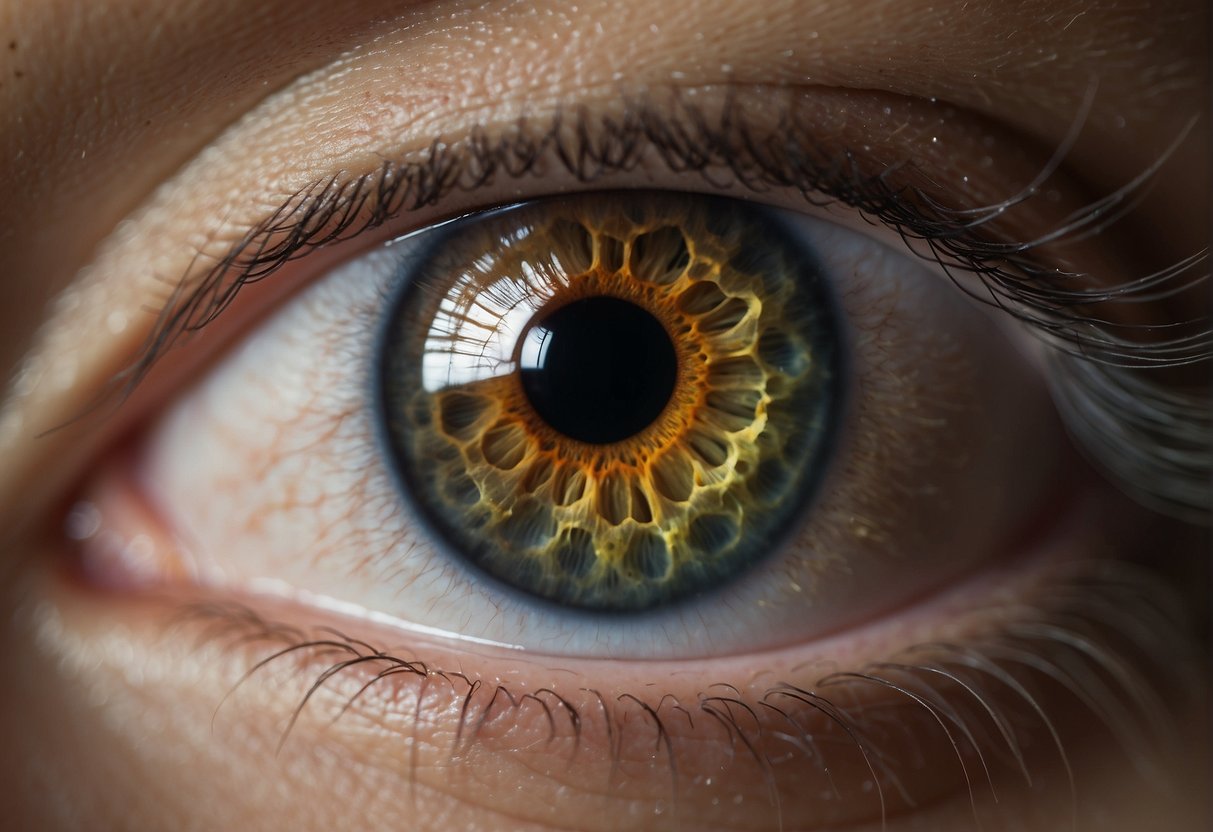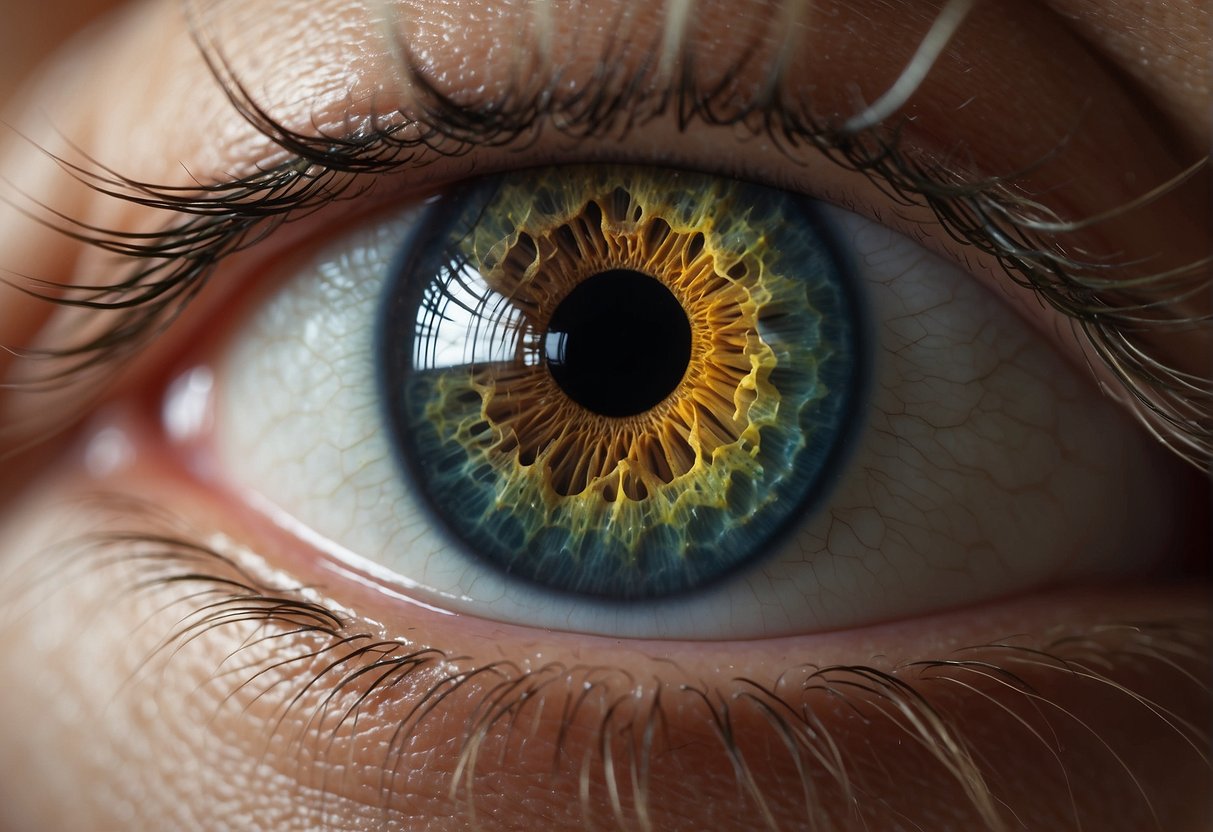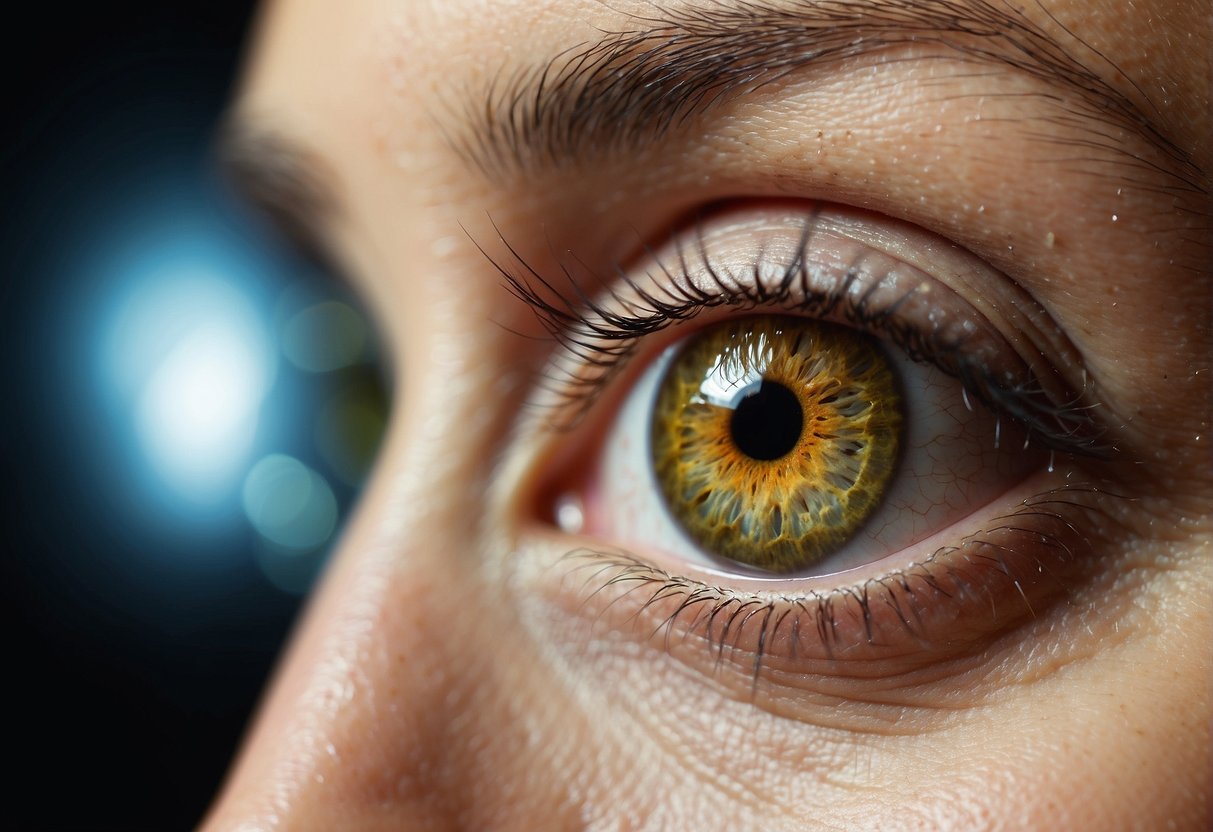
Macular Degeneration: Understanding Risk Factors and Prevention Strategies
Posted by Team Debby on 1st Mar 2024
Macular Degeneration: Understanding Risk Factors and Prevention Strategies
Macular degeneration is a medical condition affecting the retina. The retina is the inner back layer of the eye that records the images we see. It then sends them via the optic nerve from the eye to the brain.
Specifically, this condition deteriorates the macula. The macula is a small central area of the retina that is responsible for visual acuity.
As we age, our risk for developing macular degeneration increases. This is why it is often referred to as age-related macular degeneration (AMD). It is the leading cause of severe, irreversible vision impairment in people over age 60.

We experience the world visually, and our central vision plays a pivotal role in our ability to read, recognize faces, and drive. When the macula is damaged, our central vision can become blurry or wavy, and dark or empty areas may appear. This can significantly impact our daily activities and quality of life.
Fortunately, peripheral vision is usually not affected by macular degeneration. So, the condition does not typically lead to complete blindness.
Over the years, we've distinguished two primary forms of macular degeneration: dry and wet. The dry form is more common and less severe. It is characterized by the thinning of the macula and the formation of drusen, which are yellow deposits.
The wet form, although less common, is more severe. It involves the growth of abnormal blood vessels under the retina. These vessels can leak fluids or bleed and cause rapid damage.
While there is no cure for macular degeneration, we have developed treatments that can slow its progression and, in some cases, improve vision.
Understanding Macular Degeneration

We will explore the key facets of macular degeneration, focusing on its definition, the types, the crucial role of the macula, and the progression of the disease.
What Is Macular Degeneration
Macular degeneration is a common eye condition primarily affecting central vision. It occurs when the small central portion of the retina, known as the macula, deteriorates. The health of the macula is vital for tasks requiring sharp vision, such as reading and driving.
Types of Macular Degeneration
There are two main types of macular degeneration:
- Dry form: This type is characterized by the presence of yellow deposits, known as drusen, in the macula. It is the more common form and tends to progress more slowly than the wet form.
- Wet form: Less common yet more severe, the wet form involves the growth of abnormal blood vessels under the retina and macula, leading to bleeding and fluid leakage.
The Role of the Macula in Vision
The macula is responsible for our sharp, central vision, which we use for detailed activities like reading, recognizing faces, and distinguishing colors. Damage to the macula compromises these functions, significantly affecting one's quality of life.
Stages of Macular Degeneration
Macular degeneration progresses through three stages:
- Early: Characterized by medium-sized drusen and no noticeable vision loss.
- Intermediate: Larger drusen are present, and some vision loss may occur, often necessitating more light for reading and other tasks.
- Late: At this stage, noticeable vision loss has occurred due to damage to the macula.
Causes and Risk Factors

We will explore the established causes and risk factors that contribute to the onset of macular degeneration. Understanding these can help us identify and possibly mitigate the risks.
Genetic and Environmental Factors
Genetics play a critical role in the development of age-related macular degeneration (AMD). A family history of AMD significantly increases one's risk. We find that certain genes have been associated with the condition and can be passed down through generations.
- Genetic Risk Factors:
- Family history of AMD
- Presence of specific genetic markers
Environmental factors, while less deterministic than genetic factors, also influence the likelihood of developing AMD. Long-term exposure to UV light and certain pollutants can be detrimental.
- Environmental Risk Factors:
- Prolonged exposure to UV light
- High exposure to certain pollutants and toxins
Age and Lifestyle Risks
Age is the most prominent risk factor for AMD, with the condition most commonly affecting those over the age of 60. As we grow older, the risk of developing AMD increases.
- Age-Related Risks:
- Over 60 years old: Increased risk
- Progressively higher risk with advancing age
Lifestyle choices have a noteworthy impact on the risk of AMD. Smoking, in particular, has been shown to double the risk of AMD. Dietary choices and exercise impact our overall health and can indirectly affect our risk of AMD.
- Lifestyle Risk Factors:
- Smoking: Doubles the risk of AMD
- Diet: High-fat diets can increase risk
- Exercise: Sedentary lifestyle may contribute to higher risk
Additional health-related factors like high blood pressure (hypertension) have been linked to a heightened risk of AMD. Racial background also plays a part, with certain races having a higher propensity for the condition.
- Health and Demographic Risks:
- High blood pressure (hypertension)
- Racial predilections toward higher risk
Symptoms and Early Detection

In addressing macular degeneration, we recognize that early detection can significantly influence the progression of the disease. By being mindful of the initial symptoms and undergoing timely diagnostic procedures, we can take crucial steps towards preserving vision.
Recognizing the Symptoms
Macular degeneration typically presents with a gradual loss of central vision, which is key for seeing fine details and recognizing faces. In the early stages, one may notice drusen, which are tiny yellow or white deposits under the retina.
As the condition progresses, symptoms can include:
- Visual distortions: Straight lines appear wavy or bent.
- Diminished clarity: Difficulty in adapting to low light levels.
- Impaired color perception: Colors seem less vibrant.
- Dark, blurry areas or whiteout: These can occur in the center of the visual field.
Using tools such as the Amsler grid, where straight lines appear wavy to those affected, can help in identifying these symptoms.
Importance of Early Detection
Early detection of macular degeneration is paramount in slowing its progress and managing vision loss. Identifying the disease in its early stage is dependent on recognizing risk factors such as age, genetics, race, smoking, and cardiovascular health.
We should be vigilant about any changes in our central vision, as early intervention can have a profound impact on our quality of life.
Diagnostic Procedures
Upon experiencing symptoms, it's advisable for us to consult a doctor or an ophthalmologist. They may recommend several diagnostic procedures to confirm the presence of macular degeneration. These include:
- Fluorescein Angiography: An injectable dye is used to highlight blood flow in the retina.
- Optical Coherence Tomography (OCT): Provides high-resolution cross-sectional images of the retina to detect abnormalities.
| Diagnostic Tool | Description |
|---|---|
| Amsler Grid | Primary tool for detecting visual distortions at home |
| OCT | Advanced imaging technique to visualize retinal structures |
| Fluorescein Angiography | Dye-based imaging to examine retinal circulation |
It's essential for us to be proactive in regular eye exams, especially when presenting risk factors or noticing any potential symptoms.
Treatment Options

In managing macular degeneration, we prioritize halting progression and preserving as much vision as possible. Our treatment options vary significantly between the dry (non-exudative) and wet (exudative) forms of the disease.
Non-Exudative AMD Management
For dry macular degeneration, our approach focuses on lifestyle changes and nutritional supplements. We recommend:
- A diet rich in leafy greens and fish, known for their beneficial properties.
- Nutritional supplements like the AREDS2 formula, which contains:
- Vitamin C
- Vitamin E
- Lutein
- Zeaxanthin
- Zinc
- Copper
This regimen aims at decelerating the progression of dry macular degeneration.
Exudative AMD Interventions
When treating wet macular degeneration, we utilize advanced therapies to address abnormal blood vessel growth.
- Vascular Endothelial Growth Factor (VEGF) Inhibitors: The most common treatment involves intravitreal injections of anti-VEGF medications. These injections can reduce vessel permeability and inhibit further growth. The agents used include:
- Bevacizumab
- Ranibizumab
- Aflibercept
- Photodynamic Therapy (PDT): This involves the injection of a light-sensitive drug, followed by a focused laser to activate the medication and close off abnormal vessels.
For the latest intervention, Avacincaptad Pegol, it's still under investigation, showing promise in reducing the rate of geographic atrophy in dry AMD.
Living with Macular Degeneration

As we face the reality of macular degeneration, it's crucial to adapt our lifestyles, seek appropriate support, and understand potential future complications. Here, we guide you through these aspects for better management of the condition.
Adapting Daily Life
After a macular degeneration diagnosis, we need to adapt our daily routines. Tasks that rely on central vision, such as reading and recognizing faces, may become challenging.
To address this, we use a combination of coping strategies:
- Magnification tools: We utilize devices such as magnifying glasses or digital screen readers to assist with reading and detailed tasks.
- Lighting adjustments: Bright, evenly distributed light can greatly improve our clarity of vision.
- Contrast enhancement: High-contrast colors help us differentiate objects and text more easily. For example, we may use black ink on white paper.
- Peripheral vision training: Since macular degeneration affects only the central visual field, we can learn techniques to make better use of our peripheral vision or side vision.
Support and Resources
Finding emotional and informational support is key to maintaining our well-being while living with macular degeneration:
- Support groups: Engaging with others who share our experiences can lessen feelings of isolation and depression. These groups provide a space to exchange tips and encouragement.
- Professional help: Mental health professionals can address symptoms of depression that we or our loved ones may experience.
- Educational resources: Institutions and charities offer advice on living with low vision and connect us with services like low vision rehabilitation.
Encountering visual hallucinations, such as those in Charles Bonnet Syndrome, can be distressing. But being aware that these are not uncommon in macular degeneration can alleviate concern.
Future Complications
Understanding potential complications associated with macular degeneration enables us to seek timely care:
| Complication | Description | Management Strategy |
|---|---|---|
| Loss of Reading Ability | Difficulty reading as central vision worsens. | Utilize audio books or screen readers. |
| Increased Risk of Blindness | Progression can lead to significant vision loss. | Regular check-ups to monitor the condition and adapt strategies. |
| Safety Concerns | Greater risk of falls or accidents due to poor vision. | Implement home safety measures to prevent accidents. |
By being mindful of how our visual field may change, we can plan ahead for safety modifications in our homes and seek advice or treatments that may slow the progression of vision loss.
Nutritional and Lifestyle Considerations

We recognize that both nutrition and lifestyle play a crucial role in the health of the macula. Ensuring a well-balanced diet rich in certain nutrients and maintaining a healthy lifestyle can be significant in slowing the progression of macular degeneration.
Dietary Impact on Macular Health
A diet that supports macular health includes several key nutrients. Omega-3 fatty acids are essential for retinal health and are abundantly found in fish like salmon and flaxseeds.
Antioxidant vitamins, such as vitamin C, vitamin E, and beta-carotene, also contribute to the protection of the macula and are present in a variety of fruits and vegetables.
It’s important to limit the intake of saturated fat which can be detrimental to macular health. We should opt for lean meats and low-fat dairy products to reduce these fats in our diets. Here is a list summarizing foods beneficial for macular health:
- Fruits and vegetables: Especially dark, leafy greens like spinach and kale
- Fish: High in omega-3 fatty acids, such as salmon, mackerel, and sardines
- Nuts and seeds: Such as almonds and flaxseeds for vitamin E
Benefits of Exercise and Weight Management
Regular exercise contributes to overall health and can particularly aid in weight management. Carrying excess weight or being obese heightens the risk of developing obesity-related cardiovascular disease, which can indirectly impact macular health.
By maintaining a healthy weight through exercise and proper diet, we can reduce the strain on our cardiovascular system and potentially decrease the risk of worsening macular degeneration. Here is how we might incorporate exercise into our routine:
- Aerobic exercises: Like walking, swimming, or cycling for at least 150 minutes per week
- Resistance training: Including weights or resistance bands to help maintain muscle mass
We also recognize that smoking is a highly damaging habit for macular health. It increases the risk of macular degeneration and stopping smoking can significantly reduce this risk.
Preventive Measures and Regular Care

In addressing macular degeneration, we emphasize the importance of preventive strategies and routine care particularly focused on early detection and slowing disease progression.
Routine Eye Exams and Self-Assessment
Regular eye exams are of paramount importance, as they allow for the timely detection of early-stage age-related macular degeneration (AMD) and the intervention that can slow its progression. We advise individuals to adhere to the following guidelines:
- Early AMD: Have comprehensive eye exams every two years starting at age 50.
- Intermediate AMD: Increase the frequency of exams to annually.
- Late AMD: Follow the retina specialist’s recommendations for monitoring and treatment.
For self-assessment, the Amsler grid is a useful tool for detecting vision changes related to macular degeneration. Any appearance of wavy lines or blind spots warrants immediate reporting to an eye care professional.
Advancements in Prevention Research
We’re continually monitoring the latest research to update our prevention strategies. Recent studies have pinpointed:
- Genetic Predictors: Identifying genetic markers that may predict the development of AMD to individualize preventive care.
- Dietary Influences: Emphasizing diets rich in lutein and zeaxanthin which can lead to pigment density changes, potentially protecting against AMD:
Nutrient Foods High in Nutrient Lutein Kale, Spinach, Broccoli Zeaxanthin Corn, Eggs, Citrus fruits - Lifestyle Adjustments: Advocating for smoking cessation and UV protection to reduce the risk of AMD progression.
Incorporating the latest findings into our preventive measures ensures that we stay at the forefront of combating this condition. Through vigilant research and regular care practices, we aim to lessen the impact of macular degeneration on our patients’ lives.
Future of Macular Degeneration Research

We are witnessing a pivotal moment in the fight against macular degeneration, as research and treatment approaches continue to advance. Our understanding of this condition is deepening, paving the way for groundbreaking innovations and improved patient outcomes.
Current Research Trends
In our pursuit to combat macular degeneration, we are currently focusing on the genetic and environmental factors that influence the disease’s onset and progression.
Studies are honing in on discovering biomarkers for early detection, which are crucial for preventing the severe loss of vision. We are also exploring the protective role of certain nutrients and lifestyle modifications in slowing the disease’s progression.
Our efforts have led to the identification of various genes associated with macular degeneration, enhancing our ability to predict who might be at higher risk for developing the condition.
Notable advancements in current research include:
- Enhanced imaging techniques for the early detection of light-sensitive cell damage.
- Investigations into the role of inflammation and the body’s immune response in the disease’s advancement.
Innovations in Treatment Approaches
Our approach to treatment is evolving rapidly, with several innovative methods showing potential to reduce the severity of macular degeneration and preserve vision.
Noteworthy among these is the development of advanced pharmacologic therapies that aim to protect and nourish the light-sensitive cells of the retina.
Key innovations in treatment include:
- Stem cell therapy: Efforts to replace damaged light-sensitive cells.
- Gene therapy: Targeted corrections of genetic defects causing or contributing to the disease.
- Implantable devices: To enhance visual acuity by compensating for blind spots in patients’ fields of vision.
Through these treatments, we are striving to reduce the impact of macular degeneration significantly, offering hope to millions who face the prospect of vision loss due to this condition.
Frequently Asked Questions

We understand that navigating information regarding macular degeneration can be challenging. In this section, we provide concise answers to some of the most commonly asked questions to give you a clearer understanding of the condition and its management.
What are the available treatments for macular degeneration?
Currently, there are several treatment options for macular degeneration, including anti-VEGF injections to slow vision loss in wet macular degeneration and, in some cases, laser therapy. Supplements can also be recommended to manage the progression of dry macular degeneration.
Is it possible to slow the progression of macular degeneration?
Yes, progression can often be slowed with lifestyle changes such as a nutritious diet, exercising regularly, and wearing sunglasses outdoors. Regular eye exams are also crucial for monitoring the condition.
What self-care measures can individuals take for macular degeneration?
We advise individuals with macular degeneration to maintain a healthy diet with plenty of leafy greens, exercise regularly, protect their eyes from UV light with sunglasses, and avoid smoking. These steps can contribute to better eye health.
How can wet macular degeneration be managed?
Managing wet macular degeneration typically involves regular anti-VEGF injections to reduce blood vessel growth. Laser therapy may also be used to seal leaking vessels. Consistent treatment is essential for managing this type of macular degeneration.
What are the potential causes of macular degeneration?
The causes of macular degeneration include aging, genetic factors, a history of smoking, high blood pressure, obesity, and prolonged sun exposure. A combination of these factors usually contributes to the development of the disease.
What is the expected time frame for macular degeneration to affect vision significantly?
The progression of macular degeneration varies significantly among individuals. Some may experience a gradual decline in vision, while others may encounter a more rapid onset.
Early detection and treatment are pivotal in delaying significant vision loss.

